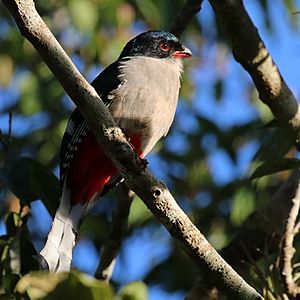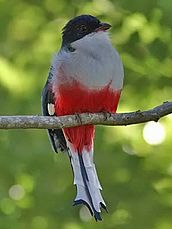Cuban trogon facts for kids
Quick facts for kids Cuban trogon |
|
|---|---|
 |
|
| A tocororo in Viñales Valley, Cuba | |
| Conservation status | |
| Scientific classification | |
| Genus: |
Priotelus
|
| Species: |
temnurus
|
 |
|
The Cuban trogon or tocororo (Priotelus temnurus) is a beautiful bird found only in Cuba. It belongs to the Trogonidae family. This special bird is also the national bird of Cuba!
Contents
About the Cuban Trogon's Family
The Cuban trogon is related to the Hispaniolan trogon. They are the only two birds in their group, called Priotelus.
Different Types of Cuban Trogons
There are two slightly different kinds, or subspecies, of the Cuban trogon. One is called P. t. temnurus. The other is P. t. vescus. They look very similar.
Why it's Called Tocororo
In Spanish, people call this bird the tocororo. This name sounds like the bird's own call! It comes from its repeated song, which sounds like "toco-toco-tocoro-tocoro". This bird is very important to Cuba. It is their national bird.
What the Cuban Trogon Looks Like
The Cuban trogon is about 23 to 28 centimeters (9 to 11 inches) long. It weighs between 47 and 75 grams (1.7 to 2.6 ounces). Both male and female birds have the same colorful feathers. Their colors match the flag of Cuba!
Feather Colors
Their beak is reddish-pink with a dark top part. Adult birds have a black face and reddish eyes. Their head and neck are a shiny dark blue. Their back is a metallic green. Their cheeks and throat are white, turning gray on their chest. The lower part of their belly and under their tail are bright red.
Tail and Wings
Their tail feathers are different lengths, making a pointed shape. The inner tail feathers are glossy blue-black. The outer tail feathers are mostly white with blue-black bases. Their wing feathers are dark metallic green to black. They have a cool pattern of white spots. Young birds look similar to adults but are a bit duller.
Where the Cuban Trogon Lives
The main type of Cuban trogon (P. t. temnurus) lives all over the main island of Cuba. You can also find it on some big islands near the Camagüey Province. The other type (P. t. vescus) only lives on Isla de la Juventud.
Its Home
These birds live in both old, untouched forests and forests that have grown back. They also live in bushy areas and smaller woods near rivers. They like humid, shady spots in these places. You can find them at all heights, but they are most common in higher areas.
How the Cuban Trogon Behaves
The Cuban trogon usually stays in one area. However, it might move to different heights or places during certain seasons. This happens if they need to find more food. Their flight is a bit choppy and can be noisy.
Social Life
You will usually see Cuban trogons in pairs. Sometimes, you might even see groups of three or four birds. They don't seem to mind if people are nearby.
What They Eat
Cuban trogons usually look for food in the middle parts of the forest. They fly out from a branch to catch food. They might also hover near leaves or fruit. Their diet is mostly insects, fruits, and plant buds. They also feed small lizards to their young.
Raising a Family
The Cuban trogon's breeding season is mostly from April to July. They build their nests in natural holes in trees. They also use old holes made by woodpeckers. Sometimes, they even nest in termite nests in trees. A female usually lays three or four eggs. The eggs hatch in about 18 days. The young birds are ready to fly about 21 days after they hatch.
Their Calls
The Cuban trogon's song is a nice "toco-toco-tocoro-tocoro..." sound. They repeat this song often for long periods. They also make a fast series of short, sharp notes. Sometimes, they make a low, sad call that can be hard to find.
Is the Cuban Trogon Safe?
The IUCN says the Cuban trogon is a species of "Least Concern." This means it is not in immediate danger. It lives in a large area. However, we don't know exactly how many there are. Their numbers are thought to be going down.
Threats to the Bird
No big, immediate dangers have been found for them. They are common on the main island of Cuba. But they are rare on the small islands and not common on Isla de la Juventud. Cutting down forests and breaking up their homes are two of the biggest threats to the Cuban trogon.
Gallery
See also
 In Spanish: Tocororo para niños
In Spanish: Tocororo para niños





